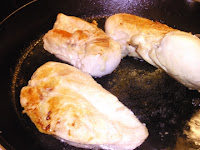 |
| Grandma's Pans |
I like old pans, and new ones that have been made in the US. Lodge pans are easy to come by, but aren't as smooth as my old ones. Still working out if that's a benefit or not. I cook also in ceramic and glass, even stainless steel if I know they haven't been made with impurities and other metals that will leach into our food.
Getting an old cruddy and rusty pan back on the stove isn't as hard as you would think. I have one now that looks like it's ready for the trash. All it needs is some time in the oven on "self clean". One cycle will turn all the old built up seasoning to ash. Any rust that remains can be removed with a stiff wire brush. I like using the wire brush attachments for my drill. Then I rinse the pan with water only, soap will soak into the metal at this point. Completely dry the pan, coat it all over with oil, place it in the oven upside down and bake it for an hour at 400 degrees. If you don't want oil drips on the bottom of your oven, place a cookie sheet on the rack below the pan. Let the pan cool completely before moving it. Rinse the pan again, completely dry it, give a light coating of oil.
 How you cook with your pan will determine your cleanup, here I'm frying some skinless boneless chicken breast. You can see the oil is hot enough to bubble, yet not too hot to cause the chicken to stick. How hot you cook in your oil will also determine how much is absorbed into your food. Hot enough to seal out the oil and in the juices...yet not too hot to stick can take some practice, but is oh so worth it!
How you cook with your pan will determine your cleanup, here I'm frying some skinless boneless chicken breast. You can see the oil is hot enough to bubble, yet not too hot to cause the chicken to stick. How hot you cook in your oil will also determine how much is absorbed into your food. Hot enough to seal out the oil and in the juices...yet not too hot to stick can take some practice, but is oh so worth it! 
Cleaning up after the chicken wasn't bad at all! I even let it sit over night. I use my scrapers for my stoneware, hot water and only a small amount of mild soap if it's tough to get out. Soap cuts grease and is damaging to your seasoning coat on the pan. After a good rinsing, I wipe a thin coat of oil and hang it on the wall.
Whatever you do, don't put them in the dishwasher or let them sit in water. You will not have ruined your pan, but you will have to go through the re-seasoning process.
In my old smooth pans, I can scramble or fry eggs and cleanup is only a wipe! I use real butter and keep the pan on low. I'll leave the benefits of cooking with real butter for another day, but while I'm on the subject of health...
Did you know that not only do you reduce health risks, but there are health benefits when you cook in cast iron? (I like the part at the end of that article, when Dupont says teflon is safe :/ Check out this article by Good Housekeeping where they tested the pans, page 2).
We live in a busy world of quick meals and fast cleanup. By slowing things down a little, I get to take care of my health and the health of my family. I also get to take time to reminisce about dinners past.
If links above are not working: Lodge pans http://www.lodgemfg.com/Logic-product.asp
Heath benefits article http://environment.about.com/od/healthenvironment/a/safecookware.htm
Good Houskeeping tests http://www.goodhousekeeping.com/product-testing/reviews-tests/kitchen-cooking/nonstick-cookware-safety-facts
No comments:
Post a Comment